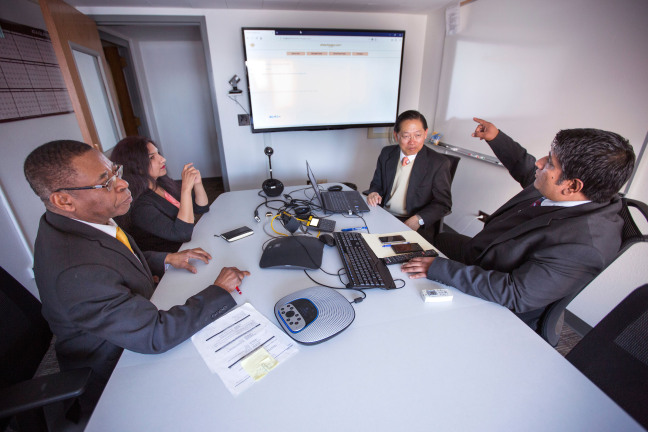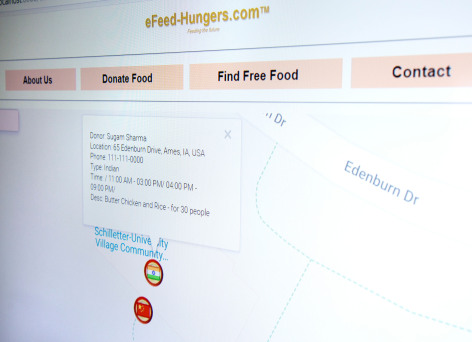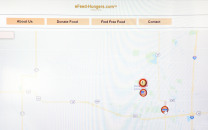
Sugam Sharma (right) leads a discussion about a software prototype to connect food donors with food pantries in Iowa. With him to his right are team members Johnny Wong, Ritu Shandilya and U. Sunday Tim. (Larger image) Photos by Christopher Gannon
AMES, Iowa – Sugam Sharma remembers as a child listening to his parents talk about hunger. While his family always had enough to eat, hunger was prevalent and something he regularly witnessed growing up and as a young adult in India.
“It is really heart wrenching to witness a mother in shabby and torn clothes, holding her baby, come to you and ask for help because her baby hasn’t had anything to eat,” Sharma said. “This I have witnessed often in my life.”
Those interactions made an impression and heightened Sharma’s awareness of hunger. When he moved to the U.S. in 2006 to continue his education, Sharma says he quickly recognized hunger was not just a problem in India. What he found most troubling was the amount of food wasted – in the U.S. and India – when so many people go without. After reading about elementary schools sending food packages home with students, Sharma decided to make hunger the primary focus of his research.
Given that 40 percent of the food produced in the U.S. is wasted, according to the USDA’s Economic Research Service, Sharma wanted to find a way to divert excess food to those in need. It has taken almost three years for Sharma, a computer science expert and systems analyst in Iowa State University’s Center for Survey Statistics and Methodology, and his collaborators to develop a software prototype – eFeed-Hungers – to do just that.
Ritu Shandilya, a third-year Ph.D. student in computer science; U. Sunday Tim, an associate professor of ag and biosystems engineering; and Johnny Wong, professor and associate chair of computer science, are all part of the research team. Their work is published online in the journals Resources, Conversation and Recycling, and Telematics and Informatics.
Making the connection
A program that distributes leftover food from catered events to the homeless in India inspired the vision for the online, interactive network, Sharma said. Restaurants, grocery stores and individuals can use the mobile-friendly software to post food they have to donate. Likewise, those in need can find nearby locations where food is available for pickup.
The researchers designed the software so donors take the food to a public place, such as a food pantry or church serving free meals, for pickup and distribution. It allows for one-time and recurring donations, so businesses or individuals do not have to enter their information repeatedly. Sharma says the interactive map makes it easy to search. Each location is marked with a flag to indicate the type of food, and hours it is available.
“We wanted to make it as simple as possible, so people will not hesitate to donate,” Sharma said. “There is no scarcity of food. We see this as a way to take some of the food we’re wasting and save it by providing a channel to get the extra food to the needy.”
Test to implementation
Researchers continue to test the prototype and plan to launch the site for the Ames community in late summer or early fall. Sharma says they are working on funding to provide education and outreach for restaurants, food pantries, churches and residents interested in participating. Their goal is to add gradually other cities and regions that may benefit from the tool.
“Almost everyone has a cell phone and the technology has the potential for a much wider outreach,” he said. “I don’t know how successful we will be, but we’re making an honest effort to tackle this problem. If we can help provide food for even one percent, we’ll be happy.”
Contacts
Sugam Sharma, Center for Survey Statistics & Methodology, sugamsha@iastate.edu, 515-294-3364
Angie Hunt, News Service, amhunt@iastaste.edu, 515-294-8986
Quote
“We wanted to make it as simple as possible, so people will not hesitate to donate. There is no scarcity of food. We see this as a way to take some of the food we’re wasting and save it by providing a channel to get the extra food to the needy.”
Sugam Sharma, systems analyst in ISU’s Center for Survey Statistics and Methodology
Quick look
An Iowa State University research team is testing a new online tool to provide food to those in need by reducing food waste.

